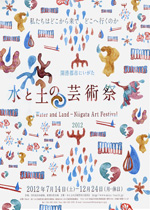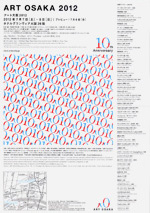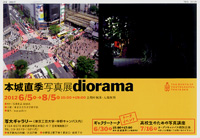 |
Picks is a monthly sampling of Japan's art scene, offering commentary by a variety of reviewers about exhibitions at museums and galleries in recent weeks, with an emphasis on contemporary art by young artists. |
 |
 |
 |
3 September 2012 |
 |
| 1 | 2 | |
 |
|
 |
 |
|
|
 |
 |
 |
 |
| KATAGAMI Style: Paper Stencils and Japonisme |
| 28 August - 14 October 2012 |
Mie Prefectural Art Museum
(Mie) |
 |
| Katagami are the paper stencils used in Yuzen and other traditional Japanese textile-dyeing arts. Despite the artisanal pride taken in the quality of katagami designs, the stencils were long treated as expendables, and were often sold overseas with no thought given to preserving them here in Japan. This traveling exhibition, which has already appeared at Tokyo's Mitsubishi Ichigokan Museum and the Kyoto National Museum of Modern Art, examines the influence of katagami on Western artists and designers from the late 19th century on, and how this legacy is reflected in contemporary work. |
|
 |
 |
 |
 |
|
|
Water and Land -- Niigata Art Festival 2012
|
| 14 July - 24 December 2012 |
Various sites in Niigata City
(Niigata) |
 |
| Niigata's sprawling citywide Water and Land Art Festival was launched in 2009 under the directorship of arts impresario Fram Kitagawa. For this second effort Kitagawa has stepped aside and four co-directors -- Yuu Takehisa, Hisako Horikawa, Yoshihiko Tanji, and Tetsuo Sato -- are in charge. The centerpiece is a giant installation by Noriyuki Haraguchi, Yoshihide Otomo, and Norimizu Ameya on the Bandaijima pier, while works by Shizue Ukaji, Motoyuki Shitamichi, Tanotaiga and others are on display in a converted "marine products hall" nearby. Buses take visitors to more far-flung sites featuring works by Anne Graham, Ai Sasaki, Irina Zatulovskaya, Naoki Ishikawa, and Tatsu Nishino. |
|
|
|
|

|
 |
 |
|
|
|
|
|
 |
 |
 |
|
|
Art Osaka 2012
|
|
6 - 8 July 2012
|
Hotel Granvia Osaka
(Osaka) |
 |
| Held annually since 2002, this art fair boasted the participation of some 50 galleries in its tenth incarnation this past July, with each gallery occupying a guest room on the 26th floor of a downtown Osaka hotel. Room 6016, which hosted Osaka's Gallery Hosokawa, was filled with a memorable installation by Yukiko Nishiyama, while Naoki Kataguchi's recent paintings made a powerful impression in room 6108, temporary domain of Kanazawa's Inform Gallery. |
|
|
|
|
|
|
 |
 |
|
| Naoki Honjo: diorama |
| 5 June - 5 August 2012 |
Shadai Gallery
(Tokyo) |
 |
| Photographer Honjo's trademark is his use of the tilt function on a 4 x 5 inch large-format camera to focus on just one part of an image, blurring the rest of it. This technique, which can be seen in his best-known series, small planet, achieves a truly diorama-like effect that one never tires of looking at. Whereas this earlier work utilized natural light and a bird's-eye view of the subject, his new series, Light House (2002, 2011), captures city streets at night under artificial light in a manner that makes them resemble meticulously constructed scale models of the real thing. |
|
 |
 |
 |
|
| Fumiaki Aono |
| 6 - 22 July 2012 |
Gallery Turnaround
(Miyagi) |
 |
| Local artist Aono's show at Sendai's Gallery Turnaround showcases works that are bizarre fusions of unrelated objects -- a boat and a desk, for example -- that the artist has "restored" from states of disrepair or abandonment. This is no exercise in the recycling of trashed goods: the "restored" items are of no practical use whatsoever. Aono was making art of this sort long before the March 2011 earthquake and tsunami devastated his hometown. After the disaster, he simply began working with objects picked up amid the debris. What has changed is not his method, but the environment in which he works. |
|
|
|
|
 |
|
|
 |
|